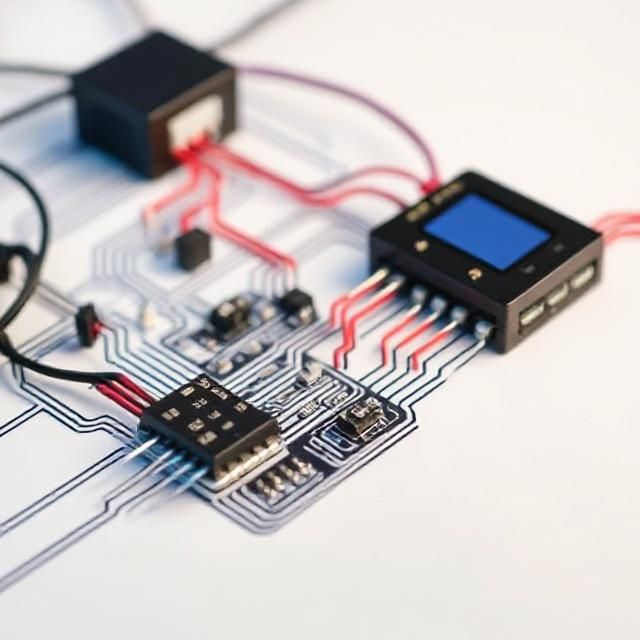What is an Oscillator?
An oscillator is an electronic circuit that generates a repeating waveform, typically a sine wave, square wave, or triangle wave. These waves are used to create signals that can be used in various applications, such as generating clock pulses for digital systems, producing sound in radios or musical instruments, and generating signals in communication systems.
In simple terms, an oscillator produces a continuous, periodic signal without needing an external input signal (like a microphone or a radio signal). The oscillator circuit creates its own signal, which keeps repeating.

Why Do We Need Oscillators?
Oscillators are used in many devices, including:
- Clocks and watches: To keep track of time using oscillating signals.
- Radios and TVs: To generate signals for transmitting and receiving information.
- Computers: To provide timing signals that keep everything in sync.
- Sound generation: In musical instruments, speakers, and other audio systems.
Basic Components of an Oscillator Circuit
To understand how an oscillator works, it’s important to know the basic components it usually consists of:
- Amplifier:
- The amplifier boosts the signal to make it stronger, which is necessary for sustaining the oscillation.
- Feedback Network:
- This network takes the output of the oscillator and feeds it back into the input of the amplifier. This is essential for creating a continuous loop that maintains the oscillation.
- Frequency Determining Components:
- These are components like capacitors and inductors (in LC oscillators) or resistors and capacitors (in RC oscillators) that help determine the frequency (how fast the signal repeats) of the oscillation.
- Power Supply:
- The circuit needs a source of power to keep working, like a battery or a power connection.
How Does an Oscillator Work?
The basic idea behind an oscillator is that the circuit needs to amplify a signal and feedback part of the signal into itself to keep the oscillation going. This feedback creates a continuous loop where the signal repeats itself, producing a periodic wave. Here’s a simple step-by-step of how it works:
- Initial Signal: The amplifier creates an initial signal, but it needs to be reinforced to keep going.
- Feedback: Part of this signal is sent back into the circuit, creating a loop. This feedback is crucial for maintaining the oscillation.
- Reinforcement: The feedback signal is amplified again by the amplifier, making the signal stronger.
- Sustained Oscillation: The process repeats itself, and the signal continues to oscillate, producing a regular wave.
Types of Oscillators
There are different types of oscillators based on the components used and the type of wave they produce. The two most common types are:
- RC Oscillator:
- Uses resistors (R) and capacitors (C) to set the frequency of oscillation.
- These oscillators are simpler and often used for generating low-frequency signals (audio signals, etc.).
- The frequency of the signal is determined by the values of the resistors and capacitors.
Example: A common RC oscillator is the Wien Bridge Oscillator, which uses a combination of resistors and capacitors in a feedback loop to create a stable sine wave.
- LC Oscillator:
- Uses inductors (L) and capacitors (C) to set the frequency.
- These oscillators are used for generating higher-frequency signals, such as in radio transmitters.
- The frequency is determined by the values of the inductor and capacitor in the circuit.
Example: A Colpitts Oscillator is a popular LC oscillator used in high-frequency applications.
- Crystal Oscillator:
- Uses a quartz crystal instead of just capacitors and inductors to determine the frequency.
- The quartz crystal has very precise properties that make it excellent for maintaining a stable frequency.
- These are used in applications where high accuracy is required, such as in clocks, watches, and computers.
Simple Example of How an RC Oscillator Works:
Let’s look at a basic RC oscillator:
- Capacitor Charging: The capacitor in the circuit begins charging through a resistor. As the capacitor charges, the voltage across it increases.
- Voltage Reaches a Threshold: Once the capacitor’s voltage reaches a certain point, it triggers the amplifier to turn on and create an output signal.
- Discharging the Capacitor: When the amplifier is triggered, the capacitor discharges through the resistor, and the cycle starts again.
- Continuous Loop: This process of charging and discharging creates a repeating waveform.
What is Feedback in Oscillators?
Feedback is a key concept in oscillators. Feedback means taking a part of the output signal and sending it back into the input to “re-inforce” the oscillation.
There are two types of feedback:
- Positive Feedback: This is when the feedback signal reinforces the original signal, making it stronger and maintaining the oscillation.
- Negative Feedback: This is when the feedback signal cancels out the original signal. While this is useful for controlling amplification in some circuits, oscillators rely on positive feedback to keep oscillating.
Important Terms Related to Oscillators:
- Frequency: The number of times the oscillator completes one cycle in one second (measured in Hertz, Hz). The frequency determines the speed at which the signal repeats itself.
- Amplitude: The height of the wave, or how strong the signal is. A higher amplitude means a stronger signal.
- Waveform: The shape of the oscillation. Common waveforms include sine waves, square waves, and triangle waves.
- Phase Shift: The delay or shift of the waveform over time. Oscillators need a certain amount of phase shift to maintain stable oscillation.
Applications of Oscillator Circuits:
- Clocks and Timing: Oscillators are used to generate the timing signals in clocks, watches, and computers.
- Signal Generators: In laboratories, oscillators are used to generate signals for testing and measurement purposes.
- Radios and Communications: Oscillators generate the carrier waves used for radio transmission.
- Audio Devices: Oscillators are used in synthesizers and audio equipment to create sound waves.
- Microcontrollers and Digital Circuits: They provide the clock pulses that synchronize operations inside microcontrollers and other digital devices.
Summary:
- An oscillator is a circuit that generates a continuous, repeating signal (like a sine wave or square wave).
- The key to an oscillator’s operation is feedback, where a portion of the output signal is sent back into the circuit to keep the oscillation going.
- There are different types of oscillators, including RC oscillators, LC oscillators, and crystal oscillators, each suitable for different applications based on their frequency and accuracy.
- Oscillators are used in many everyday devices, such as clocks, radios, computers, and audio equipment.
Oscillators are crucial for keeping time, generating signals, and enabling communication in electronic systems.
Keywords: Oscillator, Circuits, Electronics
Keywords: Oscillator, Circuits, Electronics











